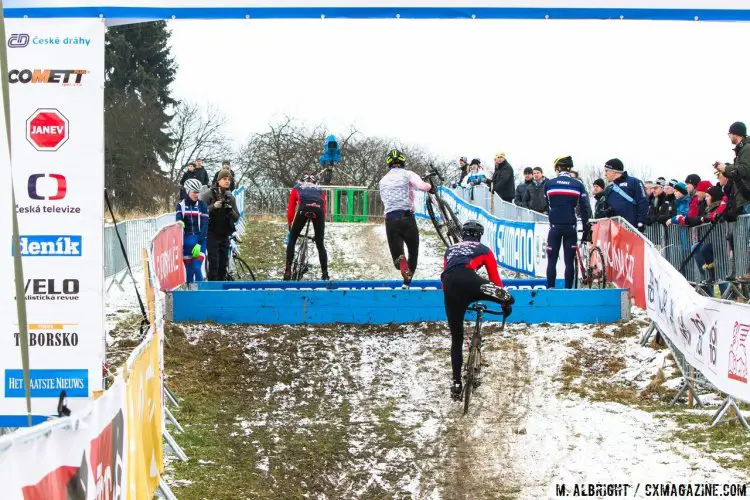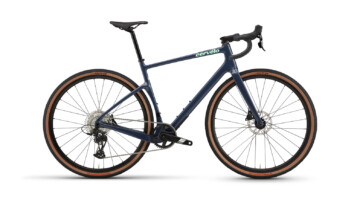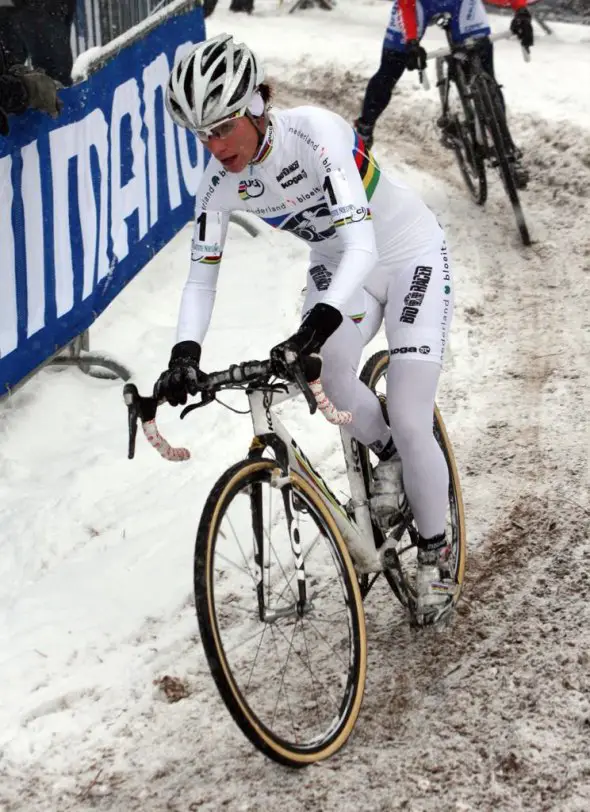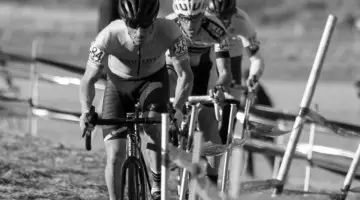
The French riders are keeping a close eye on the American dismount form as both countries practice the barriers. © Mike Albright/Cyclocross Magazine
In our last Technique Tuesday, we examined remounting of the bicycle, and the best ways to eliminate a stutter-step that can cost big placements in a cyclocross race. It is appropriate then, that Adam Myerson follows our guide up with his thoughts on dismounting during a race.
Dismounting is almost like an art over a science, with each person having a unique approach. For years, I was staunch in stepping-thru in most situations. This season, however, I changed to the Jeremy Powers method of keeping the right foot back and unclipping the left foot at the last moment. I don’t find dismounting any faster, but I do find that when I flick my foot to unclip, my crankarms rotate so that my right pedal is in a good 3 o’clock position when it’s time to remount after a set of barriers.
Myerson has a similar approach, but his involves unclipping well before the barriers. To echo what Myerson says in his clinics, there is no right or wrong way. Try many different techniques in practice and see which methods you favor the most, always keeping risk vs. reward in mind.
You can find other training ideas and articles at cycle-smart.com, as well as information on internationally-recognized coaching and clinic programs for all skill levels.
by Adam Myerson
Of all the debates about ’cross equipment choices and proper technique, it continues to amaze and entertain me that every September we renew the dismount debate: to step through, or to step around? And while I might enjoy egging that debate on for laughs, it seems to me that many people could use some straight answers. There will be purists in both camps who will not have their minds changed either way, and many who think that because they get away with a particular technique it must be the “right” way. I argue there is no single “right” way; there are multiple styles and very specific reasons for each, with advantages and disadvantages, all situationally based. I will outline all the approaches here, and when, why, and how you should apply them.
LEFT FOOT FIRST
I will begin with what I consider to be the crucial and often confounding first step required in 90 percent of dismount scenarios: you should almost always begin the process by clipping out of the left pedal as you pass through the bottom of the stroke, one or two pedal strokes before you’re actually ready to step off, and ride with the pedal under the arch of the foot. This is a show stopper for so many people who have only ever raced off-road with clipless pedals, but for those of us who started in the days of clips and straps, it’s second nature. We spent half the race riding on the backs of our pedals, unattached to the bike, and learned mounting and dismounting technique from that perspective.
Clipping out of the left pedal and learning to ride unclipped, with the pedal in arch of your foot and your instep against the crank, is the key to allowing you to step off a bicycle at 20+ MPH without fear of being inadvertently still attached to it as you try to step over a barrier. At first, some may find riding unclipped on a clipless pedal unnerving and unstable, but with practice it will begin to not only feel normal, but also secure. Typically as you dismount you make a V shape, with the bike tilted to one side slightly while your body is tilted to the other. This means that if your foot slides anywhere on the pedal, it slides towards the bike and against the crank, not away or off of it, because the pedal is angled up as the bike is angled away. Most modern ’cross shoes have rubber all the way down the sole covering the carbon, giving you even more grip. Sidi shoes are a glaring exception to this, and many riders will glue a piece of tire tread into that space for traction. There are exceptions to this first step, and I will get to them as we go, but every ’cross rider should have the ability to just open and close their heel at the bottom of the pedal stroke, allowing the the pedal to move the arch of the foot behind the cleat, and then keep pedaling.
STEP OFF
I consider “stepping off” or “stepping around the back” to be the default dismount technique. Why? Because it works absolutely every time, in every situation, without thought or confusion or miscoordination. Start by unclipping the left foot at the bottom of the stroke at least 1/2 pedal stroke before you plan to clip out of the right, then clip out of the right, again at the bottom of the pedal stroke, shift all your weight to the left pedal, and bring the right foot around the back of the bike and on to the ground underneath you. It’s the quickest and most simple way off, and is most effective at slow speed where there isn’t much time to coast, or when you may be in the midst of an “unforced” dismount like a hill, sand, or mud, rather than a barrier or set of stairs.
The negatives to this dismount is that there is a greater risk of injury at higher speeds. Crossing your right leg around behind you and dropping yourself on to it can do hip, knee, and lower back damage. It does mean, however, that you will never find yourself still fumbling to put your foot through or clip out in a hurry at the last minute before a barrier. If you learn one style, this is the style you should learn first.
STEP THROUGH
The step through style has some sort of mythical reputation as the classic or correct way to dismount, and it is just that, a myth. First, it’s not that the step through is faster, it’s that the step through is for high speed dismount situations. That’s what gives it the faster reputation. Further, it’s a holdover again from when we raced in clips and straps, and you were never attached to the bike as you approached a barrier. Because of clips and straps, you were forced to begin the dismount process much earlier, making sure you had enough speed to coast before the barrier, and giving you time to make the extra movement of moving your right foot forward instead of just dropping it to the ground.
The process here is again to clip out of the left pedal first, at the bottom of the stroke, at least 1/2 stroke before you plan to plan to step out of the right. The right foot comes around but now, instead of putting it on the ground, you move it forward between your body and your bike, so that you’re leading with your right foot rather than trailing with it as you step off.
The advantages to this technique are that your hips are square when your foot makes contact with the ground, and you can absorb the impact of high speeds with your body’s natural suspension (ankles, knees, and hips) with good alignment. That said, the use of the step through, unlike stepping off, is extremely conditional. You should only use it when you have sufficient speed and time to coast before a dismount, so that you have time to step through. Further, you should never, EVER step through if you are still clipped in on the left pedal. Never.
I realize many of you are reading that and saying “What? I do that all the time!” But think about the movement required to clip out of the pedals. It’s not just a turn of the ankles. It’s also a turn of the hips. Add speed, fatigue, and any kind of mud or dirt in your pedals, and trying to clip out of the left pedal while your right foot is forward and your hips are locked rotationally to the left, at a time when you really need to turn them to the right, means, eventually, you will not clip out of the left pedal when you want to. To get a feel for it, simply stand in your regular shoes, with your right foot on the ground a few feet in front of you, and then try to turn your left heel outward. The resistance in your psoas and the limited range of motion should be obvious. You may be getting away with it on the bike, but you will fail at some point, and you will pay with your teeth. Further, being unclipped to start lets you really see how fast you can successfully dismount. Is that really something you want to try while still clipped in?
VARIATIONS
There are times where it’s beneficial to stay clipped in on the left as you dismount, and then rely on the ability to rotate your hips clockwise to clip out as you step around the back with the right foot. Any time you have to pedal until the absolute last second before you dismount, on a climb, in mud, or any unexpected moment, you will want to remain clipped in so that you can continue to make maximum power. There’s still some risk of accidentally staying clipped in as you step off, but it’s minimized greatly by the movement of swinging the right leg around and turning the hips, and is also usually happening at a slower speed.
Right hand turns while dismounting are another situation where a rider may prefer to stay clipped in, providing some additional stability while cornering sidesaddle, but again relying on the body’s rotation to the right to clip out as they step off.
Out of the saddle dismounts are also possible, typically while climbing and at a low RPM, and require clipping out of the left while stepping off, not before. Again, in all three of these cases, there is no situation where you would ever step through while still clipped in.
The backlash against stepping through stems mainly from riders insisting on using it in all conditions, fumbling to step through at slow speeds and at the last minute, usually while still clipped on the left. In that case, it’s not an issue with stepping through, it’s an issue when when one should apply the step through. If you understand when and why to use these two major techniques and their variations, you don’t have to fight about right or wrong. It’s more a matter of appropriate or inappropriate, in the end.





























